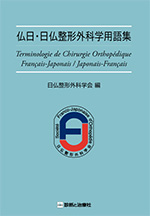新着情報
●2024/02/15
第17回日仏整形外科合同会議に関するお知らせ (第2報)
参加登録サイトが公開されました。
●2024/01/10
第17回日仏整形外科合同会議に関するお知らせ (第1報)
●2023/07/27
2024年度日仏交換留学の募集期間延長に関するお知らせ
●2023/06/28
交換研修プログラム・交換研修申請書を2024度版に更新しました。
●2023/02/01
第20回日仏整形外科学会オフィシャルサイト
●2022/05/19
交換研修プログラム・交換研修申請書を2023度版に更新しました。
●2021/11/02
第16回日仏整形外科合同会議の演題募集が開始されました。
●2021/07/12
Académie Nationale de Chirurgie (ANC) より第1回フランコフォン外科国際会議開催のお知らせ
●2020/10/01
第16回日仏整形外科合同会議は2022年に延期されました。
●2020/03/24
第19回日仏整形外科学会が延期されました。
●2020/01/11
第19回日仏整形外科学会のご案内。オフィシャルサイトを掲載しました。
第16回日仏整形外科合同会議のご案内。オフィシャルサイトが公開されました。
第15回日仏整形外科合同会議が開催されました。
●2020/06/18
第15回日仏整形外科合同会議のご案内(第3報)オフィシャルサイトが公開されました。
●2019/06/01
日仏整形外科学会事務局が移転しました。
●2019/05/08
第15回日仏整形外科合同会議のご案内(第2報)
●2019/04/24
交換研修プログラム・交換研修申請書を2020年度版に更新しました。
●2019/03/23
第15回日仏整形外科合同会議のご案内
これより前のお知らせはこちら。
仏日・日仏整形外科学用語集
日仏整形外科学会は、仏医学論文を参照するときに役立つよう日仏・仏日整形外科学辞書を作成しました。会員の方は、会員専用ページからPDFファイルでダウンロードできます。ご購入をご希望の方は事務局までご連絡ください (定価3,600円+税)。


